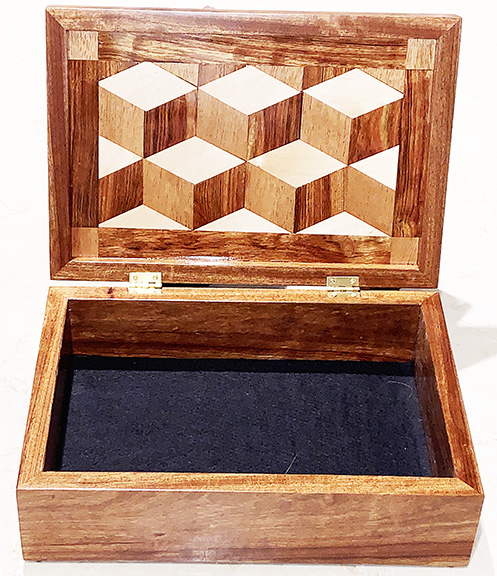

3-D Box - 105
Measures 12" x 8.5" x 4" $100


Chechen - Because of its density, natural luster, and beautiful coloration, chechen is sometimes referred to as Caribbean rosewood, though it is not a true rosewood. Heartwood color is highly varied, with red, orange, and brown contrasted with darker stripes of blackish brown. Color tends to shift to a darker reddish brown with age. It is typically used as a veneer, and for furniture, cabinetry, flooring, turned objects, and small specialty wood items.
Hard Maple - The Hard Maple Tree is usually referred to as Sugar Maple, and is the tree most often tapped for maple syrup. Sugar Maple's leaves are the shape that most people associate with maple leaves; they typically have either 5 or 7 lobes, with vivid autumn coloring ranging from yellow to purplish red. Its wood is stronger, stiffer, harder, and denser than all the other species of Maple commercially available in lumber form. (It's also the state tree in four different states in the US.) Unlike most other hardwoods, the sapwood of Hard Maple lumber is most commonly used rather than its heartwood. Sapwood color ranges from nearly white, to an off-white cream color, sometimes with a reddish or golden hue. Hard maple is commonly used for flooring (from basketball courts and dance-floors to bowling alleys and residential), paper (pulpwood), making of musical instruments, cutting boards, butcher blocks, workbenches, baseball bats, and other turned objects and specialty wood items.
African Mahogany - Found in tropical Africa, rated as moderately durable but with only moderate to poor insect/borer resistance. Heartwood ranges from pale pink to a deeper reddish brown, sometimes with streaks of medium to dark reddish brown. Colors darken with age. Quartersawn surfaces exhibit a ribbon-stripe appearance. Common uses are veneer, plywood, turned items, furniture, boatbuilding, and interior trim.